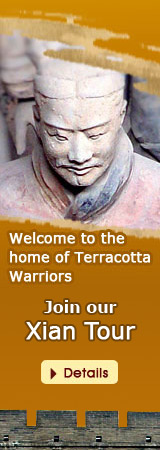Situated about 35 kilometers (21.7 mils) east of Xian city at the foot of the Lishan Mountain, the Huaqing Hot Springs is a very popular attraction for visitors to Xian. In Chinese history, emperors used to come here to bathe and enjoy the scenic beauty. It has become a favorite spa since the Tang Dynasty (618 - 907).
Originally, in the Western Zhou Dynasty (11th century BC - 771 BC), the Li Palace was built here as a vacation resort. Till the Qin Dynasty (221 BC - 206 BC) the First Emperor Qinshihuang built a stone pool, named Lishan Hot Springs. During the Han Dynasty (206 BC - 220 AD) it was extended by the Emperor Wudi.
As we can see most of the present buildings have a Tang-Dynasty style, the Hot Springs Palace was built during the Tang Dynasty by Emperor Taizong and a walled palace was added by Emperor Xuanzong in 747. Unfortunately, it was damaged during the An Lushan Rebellion in the middle period of Tang Dynasty. The present site was rebuilt on the site of the structure of the Qing Dynasty (1644 - 1911).
Entering the west gate, visitors can visit the Frost Drifting Hall, the Nine-Dragon Pool and the Lotus Flower Pool. Emperor Xuanzong of the Tang Dynasty used to spend winter with his favorite concubine -Yang Yuhuan in Frost Drifting Hall. The hall gained its name due to the slightly milky mist and vapor over the pool all year around. In winter, the snowflakes also thawed immediately in front of the Hall because of the vapor rising out of the hot spring.
The Nine-Dragon Pool is located nearby. A legend goes that a severe drought once happened in the central Shaanxi Province. The Jade Emperor (the Supreme Deity of Heaven - a legendary figure) ordered a dragon with his eight sons to rain. The dragons got slack when the disaster was just abating, and the drought became much more severe. Young dragons later were suppressed under the Jade Causeway, with the pavilions of Brilliant Dawn and Glowing Sunset built on each side. The dragons spout clear water all day long. And the old dragon was confined to the bottom of the Murmuring Dragon Pavilion at the upper end of the Jade Causeway.
However, the best way to appreciate the Huaqing Hot Springs is to take a bath. The temperature of the water keeps at 43 degrees Centigrade (109 degrees Fahrenheit) all year round. It contains lime, sodium carbonate, sodium sulphate and other minerals, which makes it suitable for bathing and for the treatment of diseases such as dermatitis, rheumatism, arthritis and muscular pain. Climbing the steps east of the source of hot springs, you will gradually see the Five-Room Hall where Chiang Kaishek stayed temporarily during the Xian Incident. Up the winding path, east of the Five-Room Hall, you will see a bridge-like structure. On summer and autumn evenings the sunshine off this bridge in a way that makes it look very much like a rainbow. So it was named the Hovering Rainbow Bridge.
The best time of period for visiting Huaqing Hot Spring is the warm spring from March to May and the cool autumn from September to November.
![]() Entrance Fee: CNY 110 (Mar. 1 to Nov. 30); CNY 80 (Dec. 1 to Feb. 28 or 29)
Entrance Fee: CNY 110 (Mar. 1 to Nov. 30); CNY 80 (Dec. 1 to Feb. 28 or 29)
![]() Opening Hours: 08:00 - 16:00
Opening Hours: 08:00 - 16:00
![]() Transportation:
Transportation:
A. Take Tourism Bus No. 5 (306) at the Eastern Square of Xian Railway Station and get off at HuaqingHot Springs stop;
B. Take Bus No. 307 at the South Gate of the Tang Paradise, Big Wild Goose Pagoda or Banpo stop and get off at Huaqing Hot Springs stop.








